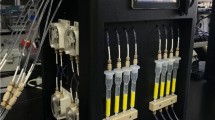Abstract
The absorber KNiFC-PAN, potassium-nickel hexacyanoferrate (II) (KNiFC) bound into modified polyacrylonitrile (PAN) is capable of absorbing radiocesium with up to 99 % recovery. KNiFC-PAN was used to collect cesium during several cruises near Fukushima, Japan, and the U.S. and Canadian west coasts by passing seawater through 5 ml of KNiFC absorber followed by counting on a germanium well detector. Other applications of this resin include in situ collection via the use of the Clio SUPR sampler during a cruise in the Marshall Islands, and development of a wearable device containing the resin.


Similar content being viewed by others
References
Breier JA, Sheik CS, Gomez-Ibanez D, Sayre-McCord RT, Sanger R, Rauch C, Coleman M, Bennett SA, Crone BR, Lib M, German CR, Toner BM, Dick GJ (2014) A large volume particulate and water multi-sampler with in situ preservation for microbial and biogeochemical studies. Deep-Sea Res I 94:195–206
Buesseler KO, Casso SA, Hartman MC, Livingston HD (1990) Determination of fission-products and actinides in the Black Sea following the Chernobyl accident. J Radioanal Nucl Chem 138(1):33–47
Buesseler KO, Jayne SR, Fisher NS, Rypina I, Baumann H, Baumann Z, Breier CF, Douglass EM, George J, Macdonald AM, Miyamoto H, Nishikawa J, Pike SM, Yoshida S (2012) Fukushima-derived radionuclides in the ocean and biota off Japan. PNAS, doi/. doi:10.1073/pnas.1120794109
Kamenik J, Dulaiova H, Sebesta F, Stastna K (2012) Fast concentration of dissolved forms of cesium radioisotopes from large seawater samples. J Radioanal Nucl Chem 296(2):841–846
Kamenik J, Dulaiova CH, Buesseler KO, Pike SM, Stastna K (2013) Cesium 134 and 137 activities in the central North Pacific Ocean after the Fukushima Dia-ichi Nuclear Power Plant accident. Biogeosciences 10:6045–6052
Pike SM, Buesseler KO, Breier CF, Dulaiova H, Stastna K, Sebesta F (2012) Extraction of cesium in seawater off Japan using AMP-PAN resin and quantification via gamma spectroscopy and inductively coupled mass spectrometry. J Radioanal Nucl Chem 296:369–374
Sebesta F, Stefula V (1990) Composite ion exchanger with ammonium molybdophosphate and its properties. J Radioanal Nucl Chem 140(1):15–21
Sebesta F (1997) Composite sorbents of inorganic ion-exchangers and polyacrylonitrile binding matrix. J Radioanal Nucl Chem 220(1):77–88
Author information
Authors and Affiliations
Corresponding author
Rights and permissions
About this article
Cite this article
Breier, C.F., Pike, S.M., Sebesta, F. et al. New applications of KNiFC-PAN resin for broad scale monitoring of radiocesium following the Fukushima Dai-ichi nuclear disaster. J Radioanal Nucl Chem 307, 2193–2200 (2016). https://doi.org/10.1007/s10967-015-4421-x
Received:
Published:
Issue Date:
DOI: https://doi.org/10.1007/s10967-015-4421-x




